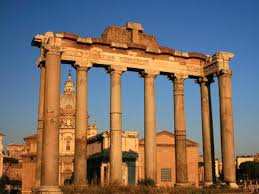Italy: Don’t do exactly what the Romans do

Rome: The passenger in the seat next to me on the noon flight to Rome keeps laughing, loudly. I’d be annoyed, but it’s my 7-year-old son, Fraser, and it’s my fault. I’ve given him Asterix the Gladiator, a comic book I loved when I was his age, to read during the flight.
After the umpteenth guffaw, I ask what’s so funny: “The gladiators are refusing to fight!”
Ceiling of the Pantheon, Rome, Italy, October 2017. Opened as a Roman temple around A.D. 126, it has the largest reinforced concrete dome in the world, with a circular hole in the center.
Ceiling of the Pantheon, Rome, Italy, October 2017. Opened as a Roman temple around A.D. 126, it has the largest reinforced concrete dome in the world, with a circular hole in the center.
Fraser has autism spectrum disorder. His condition once would have been described as Asperger’s syndrome, and he is “high-functioning,” but Fraser is happy with plain “autistic.”
He has huge, all-encompassing passions: tigers, the prehistoric era, writing comics, and ancient Rome, which he fell in love with after watching an episode of his favorite program, Horrible Histories. I’d often said I’d take him to Rome, and now I’m delivering.
It should be great fun, and our schedule is carefully planned to avoid overconsumption — we’re visiting one or two highlights a day — but I’m fretting. Rome is noisy and unpredictable, which can be stressful for anyone, much less an autistic child. I’m concerned that the city won’t live up to his expectations: Ancient structures can be beautiful, magical even, but they’re not as immediately engaging as TV shows and full-color comic books.
And then there’s the food: Was it sensible of me to agree in advance that he can have salami pizza for every meal, because he finds unfamiliar food very difficult?
I’m surprised by how unapprehensive Fraser seems, although he’s used to traveling and doesn’t always let on that’s he worried.
After we check in to our hotel, we set off to experience our first taste of Ancient Rome: the Pantheon. It’s a 20-minute trek featuring growling, hooting traffic and huge, unruly crosswalks. Fraser grips my hand and concentrates hard as a scooter threatens to collide with us. He keeps his hood up, but when I ask whether he needs his noise-canceling headphones, he says no.
As we walk, we enjoy a distant glimpse of the Colosseum, and Fraser shivers with excitement. I’ve seen the Pantheon before, but I’d forgotten how big it is. Opened as a Roman temple around A.D. 126, it has the largest reinforced concrete dome in the world, with a circular hole in the center. The height to that oculus and the diameter of the interior circle are the same, 43 meters (141 feet). Fraser spends a minute staring up at it, spinning around, before I stop him for fear he will fall over.
We leave the Pantheon in search of pizza. We’re the second people in line at the restaurant — at just after 6:30 p.m., too early for most Romans — and Fraser is impatient. “How long will it be?”
“Just a few seconds.” “1, 2, 3, 4, 5, 6 …,” he counts. “Is he cooking our pizza right now?” “Yes, Fraser, right now.”
That first night, it takes Fraser a while to fall sleep, but the weighted blanket that we’ve brought along and a stack of familiar books help. We get up at 8 a.m., and while I’m eating the breakfast supplied by the hotel, he has the same thing he has every day at home in London: two whole-grain cereal bars with a mug of weak Earl Grey tea. It’s a crucial bit of normality, especially on the morning we are headed to the Colosseum, one of Rome’s two busiest attractions (along with the Vatican), with up to 3,000 visitors at a time.
Fraser is a bundle of energy as we wait, running in circles and flapping. (This is how he expresses excitement or anxiety.) He stops now and then to offer an observation. “Did you know that the Romans invented the whoopee cushion?” I did not. (That fact came from Horrible Histories.) When we get inside, Fraser just wants to see the auditorium, which he savors in near silence.
We spend two blissful hours inspecting every nook and cranny. The fact that the Colosseum features so heavily in books and films about Rome is what makes it so important to Fraser — plus, as he tells me, animals were once kept here. It’s two passions in one place. He normally dislikes crowds, but, an occasional grimace aside, he seems OK.
He points to the cellar-level chambers and passageways that would have been covered by the stadium floor. “That’s where the gladiators and big cats were kept,” he tells me. “Were there many tigers?” I ask.
“No, most of the fights were with lions. Tigers are very well camouflaged, and lions live in groups, so it would have been easier to find them.”
In the permanent exhibition about the Colosseum on the building’s second floor, Fraser wanders up to a large chunk of engraved marble, created (a sign says) to commemorate the restoration of the arena floor after an earthquake in A.D. 443. “Can we touch it?” Fraser asks. “It doesn’t say you can’t,” I reply. Fraser, who revels in touch, is delighted.
A gull perches on the remnants of a column at the Roman Forum, the now-ruined administrative heart of ancient Rome.
A gull perches on the remnants of a column at the Roman Forum, the now-ruined administrative heart of ancient Rome.
Another pizza follows. “I don’t think they had pizza back in Roman times,” Fraser says between mouthfuls. No, I agree. “Why would you eat mice if you had pizza?” (Romans ate dormice dipped in honey, a fact that amuses both of us). “Yes,” he says, nodding.
We go to the Forum afterward. It’s my favorite afternoon of the trip: The Forum is perfection in the warm sunshine, and it’s relatively empty, except for dozens and dozens of gulls. “Do you think gulls are descended from Romans, Fraser? They seem terribly confident.” A frown. “No, gulls are descended from dinosaurs.” I leave it there.
Afterward, we spend the afternoon wandering this way and that, finishing up overlooking the Circus Maximus from the back of Palatine Hill. By 8:30 p.m. — after another pizza — we’re both dog tired. Sleep comes easily.
The next day, we start with the Baths of Caracalla, an immense, brick-built ruin perhaps 10 minutes’ walk from the Colosseum but with far fewer visitors — which is why we scheduled it to follow the excitement of the day before. It’s thrillingly atmospheric. We pause in a room that once contained a natatio, or swimming pool. “Would you like to have a bath here?” I ask Fraser. “Oh no,” he says. “I like to have my bath at home.”
After a pizza for lunch, we walk northward along the Tiber. We have a look at the remnants of Teatro Marcello, a theater begun by Julius Caesar, and eat ice cream (chocolate for Fraser). We wander over to the Trevi Fountain, where I tell Fraser that if he drops a coin in, he’ll come back to Rome. “I don’t believe that, but I’m going to do it anyway,” he says.
It has been a great three days. My fears were largely unfounded. Planning where we’d go and what we’d eat before we arrived was vital. But the key thing was Fraser’s attitude — he doesn’t like to moan and he’s pretty much always positive. He’s a perfect traveling partner. “What was the highlight?’ I ask him as we wait for our flight home. “The Colosseum,” he says, “and the infinite pizza!”





